Review: Pauline Caulfield at the Fashion and Textile Museum.
December 4, 2023Earlier this year I went to see the Andy Warhol textiles exhibition at the Fashion and Textile Museum. The museum usually has a side exhibition, and this time is was Pauline Caulfield Textile Works, 1968-2023.
Pauline Caulfield’s textile works are bold, witty, and sharply observed. They contain the humour of an artist like Claes Oldenburg, the colour sense of Ellsworth Kelly, and the interest in everyday objects of most pop artists, though in this case there are no brands, such as Andy Warhol’s Brillo pads or Campbell Soup cans, but fans, shawls, and playing cards. The artist’s name is not as well-known as those mentioned above, and the exhibition is not even the headliner. The work is all the better for this: there are no expectations whatsoever, as I did not even know I would see it, and have never seen or heard of the artist before. However, these works, in pristine condition despite being, some of them, sixty years old, definitely bear comparison and in some cases, exceed the talent of those by her better-known contemporaries.
Pauline Caulfield – So Well Observed
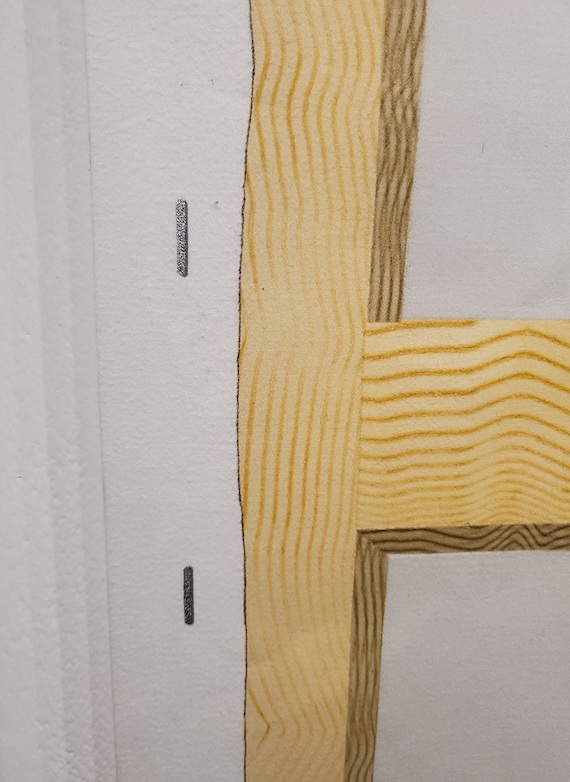
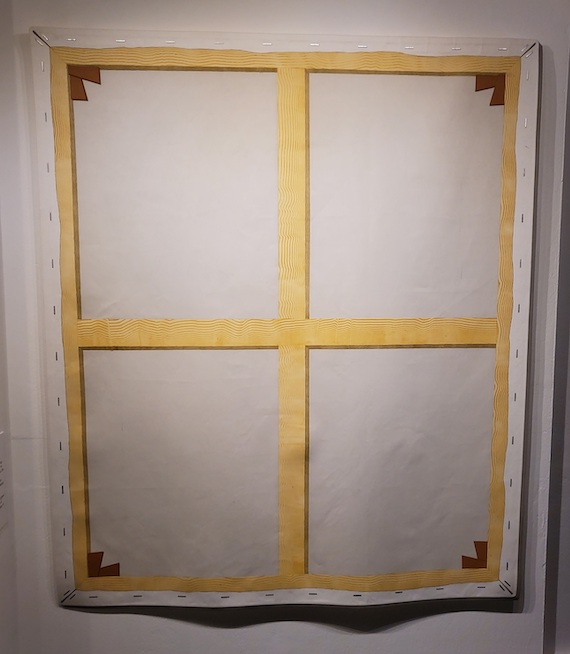
artwork
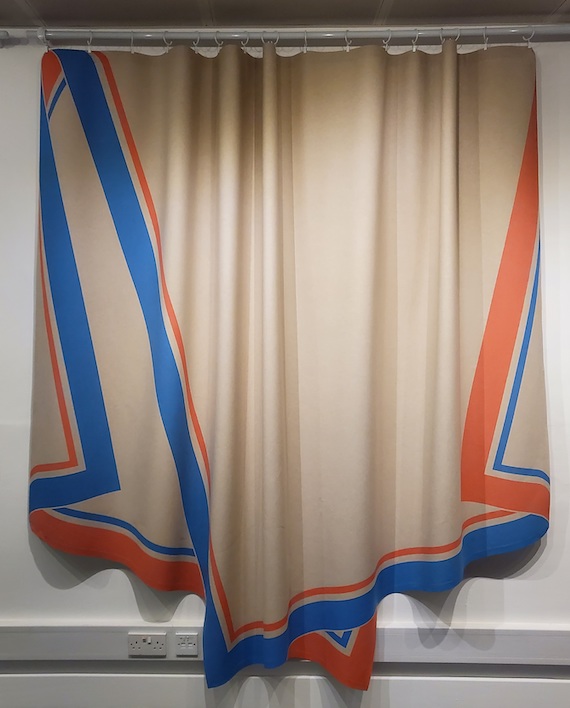
Linen Throw, 2015. Pauline Caulfield artwork
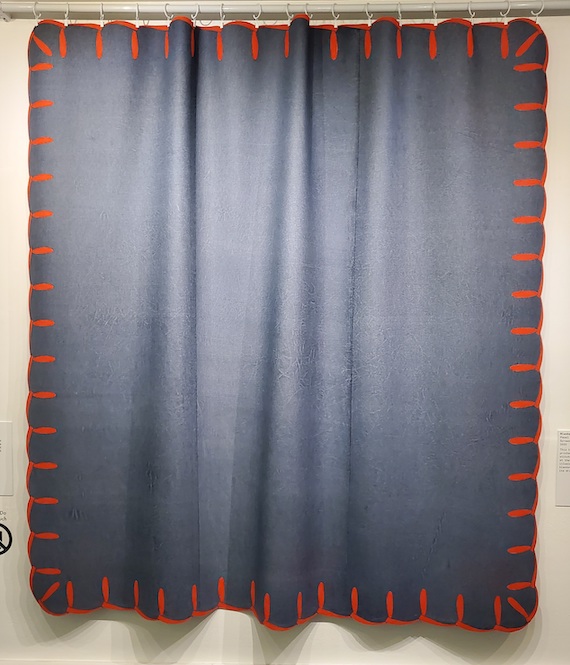
artwork
The works are large scale, bold, cheerful and witty. One I loved, really loved, was “Canvas Back”, from 2017. I feel that this is a work that can only have been made by someone who is familiar with an artist’s studio and appreciates the work of building, stretching and preparing a canvas. And as someone who has created a lot of literal blank canvases for other people, I like that Pauline Caulfield celebrates them. It is also very well depicted, with the looseness of the unpinned canvas against the wavy grain of raw wood, and the staples printed in silver with the shadows carefully observed.
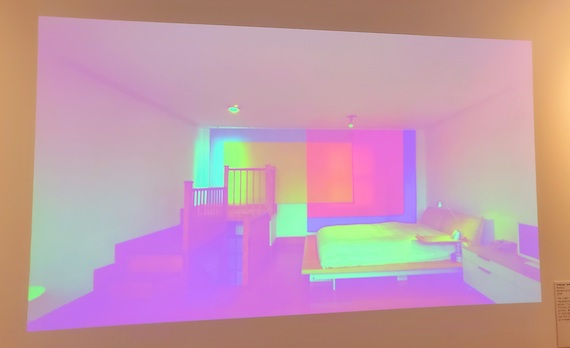
Pauline Caulfield artwork
Another work, very interesting, was shown as a film. In ”Fedelma and Jack”, from 2016, large textile panels hang across the large windows of a bedroom, as curtains would. But one is perfectly rectangular, stiff and straight, and the other, equally straight, and square. They each represent a person. The narrow rectangle in blue and yellow is Fedelma. The big red and blue square is Jack. Though both are distinct, when they cross each other they produce a new set of colours, a different glow. It’s a nice way to show two individuals combining and becoming a different, equally beautiful, thing. Many of her works are designed as window coverings as well as wall hangings.
Artistic Shiftings
Well, it’s not stated in the bio to the show and neither is it on Pauline Caulfield’s website, but with an artist working in this pop art style with this surname, I had to wonder if she might be married to the artist Patrick Caulfield. It’s revealed in this Guardian article that yes, she was, for 30-odd years. Obviously, her work stands on its own, but couples exchange ideas and it’s great to think of this cheerful meeting of minds. Like Annie Albers and Josef Albers, one artist was more interested in textiles, one in other art forms, both equally valid. In this case, I prefer Pauline’s work to Patrick’s, whose colours were always far too jarring for me, lines too thick, and the whole too clumsy-looking.
Textile works are often, by their nature, softer and warmer than works on paper. But unlike Annie Alber’s focus on creating effects through weaving, here the textiles are screen printed and so they are just the same as any work on canvas. I mean, a screen-print on canvas, stretched over a frame and mounted is technically a textile work, isn’t it? According to her bio, Pauline Caulfield actually started as a painter at the Chelsea School of Art, before moving over to textiles at the Royal College of Art.
Pauline Caulfield Early Works – Still Fresh
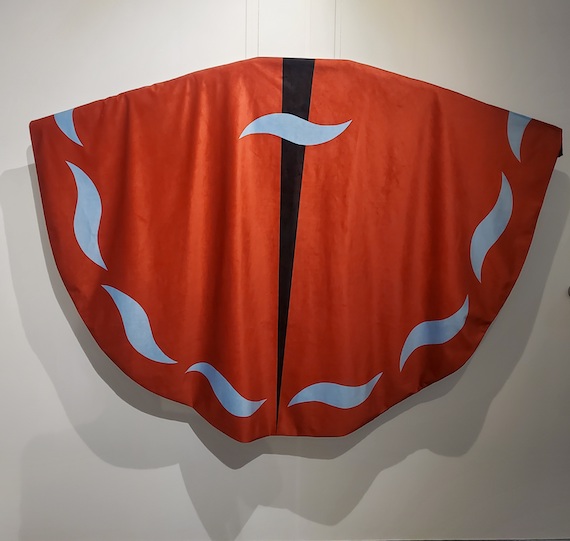
St Paul’s Red Chasubule, 1997/2023. Pauline Caulfield at the Fashion and Textile Museum.
For her diploma show, alongside eleven hangings she showed four ecclesiastical robes. It was 1968, and a fashionable art show. Safe to say that her contemporaries may have laughed up their sleeves at this rather traditional application of textiles. But I can see the appeal. If you were raised Catholic, as Pauline Caulfield was, you may notice the many rich church embroideries and be inspired by them. They have, of course, a long history in England.
The chasuble, the huge poncho-like over garment which many priests and bishops wear to conduct services is traditionally decorated in some way, often very inventively and always skilfully. It serves as a great canvas for anybody’s art. Since her graduate show Pauline Caulfield has been commissioned to create several. She has also designed copes and altarpieces. They are surprising – I mean, not surprising considering her other works but surprising for religious garments. The colour blocking is bold, and in colours like black, grey and cream. One from her degree show is pink, red and silver, with a huge motif. Another has large green chequers in-dispersed with different colours.
She says she still loves the works from her degree show and gets excited by them. Some are on show here, and I can see why. They are as fresh and clean as her works from today. Do go and see them all.
Pauline Caulfield Textile Works, 1968-2023 was at the Fashion and Textiles Museum until the 10th September 2023.